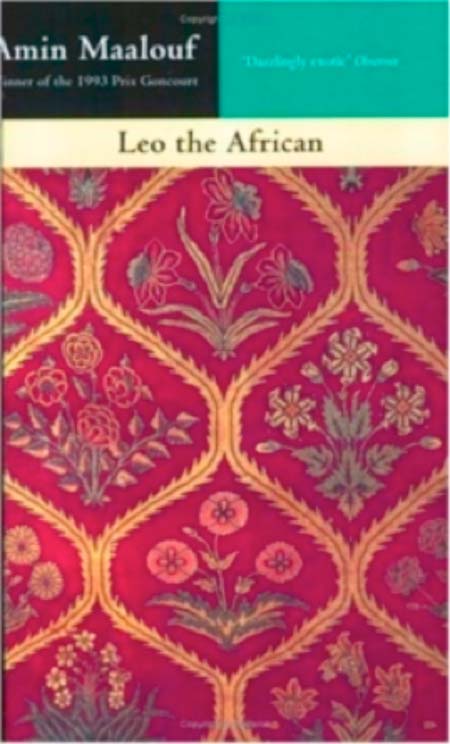
LEO AFRICANUS By Amin Maalouf
Book review by ANTON SHAMMAS
In 1992, when the New World celebrated the 500th anniversary of Christopher Columbus’s mission, Arabs and Jews were united, for a change, in musing over their lost Andalusian days, their Golden Age in Spain. Ferdinand and Isabella, before sending the Italian sailor off to look for the Indies, had already put an end to eight centuries of Muslim rule in the peninsula, returning the Arabs and Jews to the East. The Jewish memory is still haunted by the nightmare of the Inquisition, and rightly so, while the Arabs still feel nostalgic whenever the word Andalusia crosses their minds. The fall of Granada, the last stronghold of the Moors in Spain, in January of 1492 marked the Arabs’ fall from grace. It was in that year that the cross supplanted the crescent, and the kingdom that for centuries had served as a cultural liaison between the Greco-Roman world and medieval Europe came to an end.
The narrator of Amin Maalouf’s historical novel, Hasan al-Wazzan - who came to be named Leo Africanus - was born in 1488, in the waning days of Moorish Granada. At the age of 4, Hasan and his family went into exile, like many other Muslims and Jews who declined to accept the new faith and managed to flee from the outstretched arm of the Inquisition. The al-Wazzan (‘’the weigh-master’’) family settled in Fez, Morocco, where many Granadans had found refuge and hung the keys to their homes up on their walls, with ‘’the thought that soon, thanks to the Great Sultan or to Providence, they will find their house once again, with the colour of its stones, the smell of its garden, the water of its fountain, all intact, unaltered, just as it has been in their dreams.’’
Amin Maalouf, a Lebanese writer who has chosen to live in Paris and who writes in French, is infatuated by the character of Hasan al-Wazzan for a similar reason: Leo Africanus gives him the key to an imagined, tantalizing world, far away from the relentlessly real, albeit surrealistic, world of today’s Lebanon. Mr. Maalouf has already published three books in French: ‘’The Crusades as Seen by the Arabs,’’ ‘’Leo Africanus’’ and most recently the novel ‘’Samarcande.’’ As a Lebanese writer, he seems to feel more free to speak his mind in French. The passage about the Granadans who cling to the keys of their lost homes in Andalusia ends with young Hasan’s uncle telling him: ‘’Perhaps one day it may be necessary for someone to dare to teach them to look unflinchingly at their defeat. . . . But I myself do not have the courage to do so.’’ Neither has Mr. Maalouf. Three years ago, when this book was written, it would have taken a great deal of sheer Christian-Lebanese chutzpah to write these lines in Arabic, while the devastated Palestinian refugees were within earshot.
‘’Leo Africanus’’ chronicles in 40 chapters the first 40 years of the life of Hasan al-Wazzan: as a little child in Granada, a youth in Fez, a man in Timbuktu, a lover in Cairo, an emissary in Constantinople and a scholar in Rome. In the fashion of the Arabs, each year is named after the most prominent event that took place in that year. The chapters are divided into four books, after the four cities in which al-Wazzan resided: Granada, Fez, Cairo and Rome. Since he had few facts, or none, about the life of the al-Wazzan family in Granada, Mr. Maalouf is at his best here, with unbound imagination and a free hand. Salma, the mother of the long-awaited Hasan, and her rival Christian co-wife Warda with her little daughter Mariam; Muhammad the procrastinating husband, who is torn between the two, between conversion and exile; the Jewish Gaudy Sarah, who sells perfumes and tells fortunes and gossips and is almost a member of the Muslim family, and many other Granadans who watch the fall of their city - all are rendered with masterly, compassionate strokes. This invented family album is set against the falling Granada, whose effete grandeur is described through the eyes of the infant Hasan, as recalled by him many years later in Rome.
In Fez the family falls apart; the father lives with Warda, his Christian wife, and his daughter Mariam, and Hasan stays with his mother at his uncle’s house. The boy finds a lifelong friend at school, Harun, and together they roam the streets of the city, looking for juvenile adventures. They will both meet again, many years later, as the respective ambassadors of the Pope and the Grand Turk. At 16, Hasan accompanies his uncle on his first diplomatic mission, and as their caravan traverses the vast Sahara, his uncle fills in the historic gaps for young Hasan, teaching him the art of storytelling. ‘’His tone was so reassuring,’’ Hasan later recalls, ‘’that it made me breathe once more the odours of the Granada of my birth, and his prose was so bewitching that my camel seemed to move forwards in time with the rise and fall of its rhythms.’’ When the uncle dies, Hasan takes command of the caravan and returns home with his first wife, while his sister Mariam is coercively sent to the lepers’ quarter in Fez by a vengeful suitor.
In 1519, at the age of 31, Hasan, who had been abducted by a Sicilian pirate, was presented as a gift to Pope Leo X, who was later to become his patron and loving godfather, giving him his own name - Giovanni Leone. The Granadan who had been circumcised at the hand of a barber was baptized at the hand of a pope and spoke several languages of the Mediterranean, including Hebrew. Adventurer, geographer, scholar and witness to the birth and decline of kingdoms, he spent eight years of his volatile life in Rome, where he composed the first trilingual dictionary of Latin, Arabic and Hebrew. On March 10, 1526, he finished the Italian manuscript of the book that gave him his most famous name, Leo Africanus: ‘’Description of Africa, and of the memorable things contained therein.’’ The draft, apparently, was written originally in Arabic, but was later lost.
‘’Description of Africa’’ has a chapter called ‘’A most exact description of the city of Fez.’’ Over 70 pages the original Leo Africanus gives a meticulous depiction of the city, its geography, architecture, hospitals, baths, inns, mills, shops, markets, manners of eating and drinking, marriages and funerals. It is so dazzlingly colorful and rich in details that Mr. Maalouf finds himself unabashedly incorporating long passages from it into his narrative. However, Mr. Maalouf is more a storyteller here than a novelist. For instance, when he opens the Fez chapters with a description of the beautiful roofs of Fez, he does not notice even a single dove. The original description included doves ‘’in great plenty, of all colors.’’ (The missing doves also made me wonder whether Peter Sluglett, who translated the novel from the French so beautifully, had ever consulted John Pory’s English translation of ‘’Description of Africa’’ for certain phrases and words. However, I am still not sure whether it would have made a difference.) Yet that kind of detail is exactly what I find missing in Mr. Maalouf’s otherwise captivating writing - his fictitious Leo Africanus is less attentive than the real one.
And when in Rome, his Leo is just a bereft storyteller - one who has lost his audience and now is surrounded by cardinals, a pope and other intriguers. The man who witnessed the fall of the empire that had transmitted the bulk of classical knowledge to medieval Europe manages to have a chat with Raphael three months before the artist’s death, and almost bumps into the ill-tempered Michelangelo. The real reason behind his abduction, Hasan-Leo is led to believe, was the desire of Rome to open a path of negotiations with Suleiman, the rising Sultan in Constantinople, and through him with the Islamic world, a mission he tries to fulfill. However, the Rome of Mr. Maalouf’s Leo, compared to his Fez and Granada, is pontifically trite.
‘’Leo Africanus’’ is a beautiful book of tales about people who are always forced to accept choices made for them by someone else. For the American reader who is familiar only with the Columbus side of the story, it is a ‘’back at the farm’’ of sorts. It relates, poetically at times and often imaginatively, the story of those who did not make it to the New World. ‘I AM THE SON OF THE ROAD’
I, Hasan the son of Muhammad the weigh-master, I, Jean-Leon de Medici, circumcised at the hand of a barber and baptized at the hand of a pope, I am now called the African, but I am not from Africa, nor from Europe, nor from Arabia. I am also called the Granadan, the Fassi, the Zayyati, but I come from no country, from no city, no tribe. I am the son of the road, my country is the caravan, my life the most unexpected of voyages.
My wrists have experienced in turn the caresses of silk, the abuses of wool, the gold of princes and the chains of slaves. My fingers have parted a thousand veils, my lips have made a thousand virgins blush, and my eyes have seen cities die and empires perish.
From my mouth you will hear Arabic, Turkish, Castilian, Berber, Hebrew, Latin and vulgar Italian, because all tongues and all prayers belong to me. But I belong to none of them. I belong only to God and to the earth, and it is to them that I will one day soon return.
But you will remain after me, my son. And you will carry the memory of me with you. And you will read my books. And this scene will come back to you: your father, dressed in the Neapolitan style, aboard this galley which is conveying him towards the African coast, scribbling to himself, like a merchant working out his accounts at the end of a long journey.
But is this not in part what I am doing: what have I gained, what have I lost, what shall I say to the supreme Creator? He has granted me forty years of life, which I have spent where my travels have taken me: my wisdom has flourished in Rome, my passion in Cairo, my anguish in Fez, and my innocence still flourishes in Granada. From ‘’Leo Africanus.’’
Available at Timbooktoo, tel 4494345.


